- Clone
- 4C7 (See other available formats)
- Regulatory Status
- RUO
- Other Names
- CLEC4K
- Isotype
- Mouse IgG2a, κ
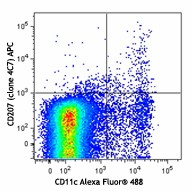
-

Cells from a collagenase-digested BALB/c mouse spleen were stained with CD11c Alexa Fluor® 488 and CD207 (clone 4C7) APC (top) or mouse IgG2a, κ APC isotype control (bottom). -

| Cat # | Size | Price | Quantity Check Availability | ||
|---|---|---|---|---|---|
| 144205 | 25 µg | $137.00 | |||
| 144206 | 100 µg | $350.00 | |||
CD207, also known as langerin, is a 40 kD single-pass type II transmembrane protein, member of the C-type lectin family. CD207 is expressed on the cell surface and Birbeck granules (BGs) of Langerhans cells, and subsets of thymic and splenic dendritic cells. Its ligands are mannose, n-acetylglucosamine, fucose, and sulfated glycans. Langerin is involved in the antigen processing pathway through capture and internalization of its ligands.
Product Details
- Verified Reactivity
- Mouse, Human
- Reported Reactivity
- Cynomolgus, Rabbit, Pig
- Antibody Type
- Monoclonal
- Host Species
- Mouse
- Immunogen
- Langerin extracellular domain-Fc fusion protein
- Formulation
- Phosphate-buffered solution, pH 7.2, containing 0.09% sodium azide.
- Preparation
- The antibody was purified by affinity chromatography and conjugated with APC under optimal conditions.
- Concentration
- 0.2 mg/ml
- Storage & Handling
- The antibody solution should be stored undiluted between 2°C and 8°C, and protected from prolonged exposure to light. Do not freeze.
- Application
-
FC - Quality tested
- Recommended Usage
-
Each lot of this antibody is quality control tested by immunofluorescent staining with flow cytometric analysis. For flow cytometric staining, the suggested use of this reagent is ≤0.25 µg per million cells in 100 µl volume. It is recommended that the reagent be titrated for optimal performance for each application.
- Excitation Laser
-
Red Laser (633 nm)
- Product Citations
-
- RRID
-
AB_2561997 (BioLegend Cat. No. 144205)
AB_2561997 (BioLegend Cat. No. 144206)
Antigen Details
- Structure
- Single-pass type II transmembrane protein, 40 kD, one C-type lectin domain, homotrimer
- Distribution
-
Langerhans cells, subsets of thymic and splenic dendritic cells
- Function
- Antigen uptake, antigen processing
- Ligand/Receptor
- Mannose, n-acetylglucosamine, fucose, sulfated glycans
- Cell Type
- Dendritic cells, Langerhans cells
- Biology Area
- Immunology, Innate Immunity
- Molecular Family
- CD Molecules
- Antigen References
-
1. Romani N, et al. 2012. Curr. Top. Microbiol. Immunol. 351:113.
2. Kaplan DH. 2010. Trends Immunol. 31:446.
3. Clausen BE and Kel JM. 2010. Immunol. Cell. Biol. 88:351.
4. Merad M, et al. 2008. Nat. Rev. Immunol. 8:935. - Gene ID
- 246278 View all products for this Gene ID 50489 View all products for this Gene ID
- UniProt
- View information about CD207 on UniProt.org
Other Formats
View All CD207 Reagents Request Custom Conjugation| Description | Clone | Applications |
|---|---|---|
| Purified anti-mouse/human CD207 (Langerin) | 4C7 | FC |
| PE anti-mouse/human CD207 (Langerin) | 4C7 | FC,IHC |
| APC anti-mouse/human CD207 (Langerin) | 4C7 | FC |
| TotalSeq™-C0437 anti-mouse/human CD207 (Langerin) | 4C7 | PG |
| PE/Cyanine7 anti-mouse/human CD207 (Langerin) | 4C7 | FC |
| PE/Dazzle™ 594 anti-mouse/human CD207 (Langerin) | 4C7 | FC |
| TotalSeq™-B0437 anti-mouse/human CD207 (Langerin) | 4C7 | PG |
| PerCP/Cyanine5.5 anti-mouse/human CD207 (Langerin) | 4C7 | FC |
| TotalSeq™-A0437 anti-mouse/human CD207 (Langerin) | 4C7 | PG |
Compare Data Across All Formats
This data display is provided for general comparisons between formats.
Your actual data may vary due to variations in samples, target cells, instruments and their settings, staining conditions, and other factors.
If you need assistance with selecting the best format contact our expert technical support team.
-
Purified anti-mouse/human CD207 (Langerin)
-
PE anti-mouse/human CD207 (Langerin)
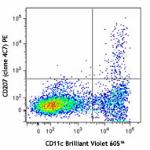
Cells from a collagenase-digested Balb/c mouse spleen were s... 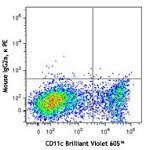
-
APC anti-mouse/human CD207 (Langerin)
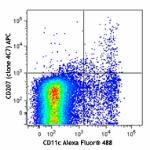
Cells from a collagenase-digested BALB/c mouse spleen were s... 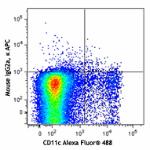
-
TotalSeq™-C0437 anti-mouse/human CD207 (Langerin)
-
PE/Cyanine7 anti-mouse/human CD207 (Langerin)

Cells from a collagenase-digested Balb/c mouse spleen were b... -
PE/Dazzle™ 594 anti-mouse/human CD207 (Langerin)

Cells from a collagenase-digested Balb/c mouse spleen were b... -
TotalSeq™-B0437 anti-mouse/human CD207 (Langerin)
-
PerCP/Cyanine5.5 anti-mouse/human CD207 (Langerin)

Cells from a collagenase-digested BALB/c mouse spleen were b... -
TotalSeq™-A0437 anti-mouse/human CD207 (Langerin)
